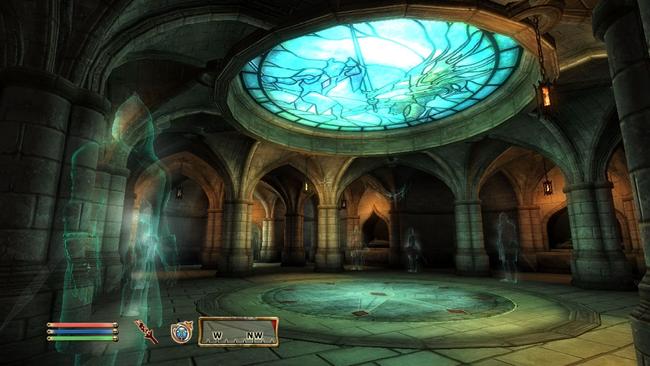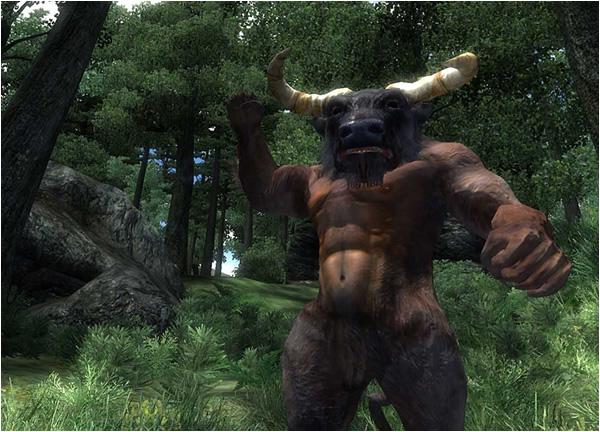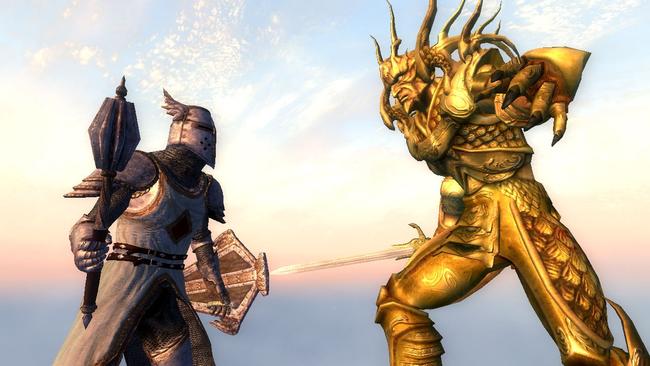
Elder Scrolls IV: Oblivion Review
If I said the word “freedom” to you, you’d interpret it in your own way. Whether it’s the freedom of speech, the freedom of movement or the freedom of your mind, your idea is also probably similar to what you seek in life, or what you believe heaven is. That single word was all Bethesda had in mind when developing Oblivion, and boy did they go out and achieve it.
The plot might twist and turn like a mountain road in Italy, but the overall principle behind the game is simple – the king has been murdered, and there is no heir to inherit the throne. Oblivion is on the move, amassing its forces ready for an attack. And your mission? Find the lost heir and using the newly opening gates, go inside Hell itself and give the invasion force an ass-kicking on their home turf.
After that, close the gates and bring peace to all of Cyrodil. Of course, as you know from RPG rules of old, things are never that straight forward. Oblivion is no exception – boasting 150 hours of gameplay, over 300 missions to complete, and that’s before they counted the downloadable content from Xbox Live Marketplace. You might think that’s an exaggeration, but after playing the game for over 65 hours and seeing only about a quarter of the world, I can honestly back up every claim ever made about this game.
Speaking of seeing only 25% of Cyrodil, the immediate thing that hits you in the face when you load up Oblivion is how gigantic the game world is. Seriously, this makes Middle Earth seem small. Each detail is so well captured, you can even see the dew on the leaves in the morning or smell the campfires littered around the place – and that’s before I saw it on a HDTV.
It’s so stunning; there’ll be various occasions where you’ll find yourself stopping dead on your way to a goblin-infested cave in the thick of dense forest only to be bowled over by the beauty of watching a world at dusk.

There are moments which are more visually arousing in Oblivion than in reality itself, but you’re usually awoken to your senses by the sound of the controller dully bouncing off the floor as your hand goes to cover your open mouth. If you didn’t believe half of that, borrow or buy the game, complete the training mission and just press the wait button and set it for 5am. Then tell me I’m talking out my rear end.
Going back to that word “freedom”, you’re probably thinking of one videogame in particular – Grand Theft Auto. San Andreas was big, I’ll admit that, but Oblivion is on a completely different scale entirely. The developers have said that the world itself is 16 miles of programmed countryside, and since the fastest modes of transport are fast travel (more on that later) or on a trusty steed, you’ll come to realize that they had a valid point.
Oblivion can be made into a completely unique game for whatever you want in every aspect. Always fancied yourself as an elite assassin? Sure thing, go ahead and join the Dark Brotherhood, or just kill for the loot. Want to be a master thief? The Thieves Guild will buy your stolen goods and help you through your chosen career.
Up for fighting to the death as a gladiator in the Arena? They’ll kit you out and fix up the matches for you, paying you as you proceed. You see, the amount of choices you can make in Oblivion is nothing short of outstanding.
Every mission can be approached in different ways, depending on what you judge to be the best way through it. For example, a woman approaches you, worried about something that keeps attacking her prized rats in her basement. It turns out to be a mountain lion, but after you’ve killed it, she’ll tell you something else is doing it, and asks you to spy on a rather suspicious neighbor.
After uncovering the violator, she’ll attempt to pay you off with a bribe. So do you take her bribe and tell the original contractor they were just hungry? Do you turn her over to the city guard and claim the reward? Do you take the bribe, then get her arrested, whilst enjoying the rewards? The choice, they say, is yours.

Before you can start with all these great choices, you have to make several right from the off – character creation. Bethesda has created one of the most detailed and customizable systems since The Sims, allowing you to adjust the obvious things like hair styles and body structure all the way to eyebrow positioning and the fullness of the lips.
With 10 different races to choose from, all with unique abilities and advantages, you’re going to have your work cut out deciding upon one you’ll stick with for the next 100 hours or so of gameplay. After creating the visual appearance, you’ll move onto deciding upon your chosen player’s abilities and attributes, consisting of several different areas. These range from Blade, Block, Hand to Hand and Blunt skills – the basic attack features – all the way to Sneaking, Conjuration, Marksmanship and Lock Picking. You can alter your choices at the end of the training mission if you’re not satisfied, but after that, there’s no going back.
The combat system is very innovative, mainly because it’s set in the First Person View – something rather unusual in the RPG genre. Although you can switch to Third Person, the dodgy camera angles and awkwardly sensitive control over your character will deter you from it, and lure you towards the perspective that the developers wanted you to see Oblivion in – no obstructions from your view.
The drawing of your weapon and attacks are governed with a simple pull of the right trigger, which allows your thumbs to be concentrating on using potions and the like – always helpful. Blocking is done in a similar way with the left trigger, whilst the right button will cast your current magic spell which you’ve selected from the easy-to-use menu system, bought up with a press of the B button. From there, you can take a look at equipment, items, magic spells, quest details, maps, your status, skills and other nifty little things such as your fame and infamy levels. With these two factors, some quests won’t become available to you at certain levels of either, and guards will also treat you differently. The phrase ‘’too much of a good thing’’ comes to mind here.
Quests are taken on incredibly easily, with a small entry being added into your journal every time you accept a quest. From there, you can choose to follow it up now, or after you’ve finished whatever you were planning on doing for the next hour or so. You’re also given nice hints and tips, as well as map pointers so that you’ll never get lost on a mission or be unsure of what to do next – a quick glance at your journal should be more than enough to complete the mission.
But don’t think that the quests are all easy because the game gives you a great big hand in the matter – usually the conditions of the quest or the logic behind it will still prove challenging, as they vary immensely from mission to mission. In one, you’ll be asked to murder someone, but make it look like an accident to claim an extra reward. In others, you’ll have to search far and wide for an item to pay off a girl’s debt, or you could save yourself some time and pay it off with the Septims (currency) you’ve amassed throughout the course of your problem solving and dungeon looting.

Now, that fast travel feature I mentioned earlier is accessible through the games map, allowing you to travel to any city or areas previously explored by you without the need to risk your life by trekking across half of Cyrodil, only to get smacked by a Frost Atronach towards the end and have to start the entire journey again. Fast travel eliminates the tediousness of having to walk or ride everywhere for hours and hours so you can complete a quest – if you’ve already taken the time out to explore the beautiful world, you won’t have to.
The monsters and NPC’s in the game level up in skills just as you do – meaning that they’re always be a challenging enemy for you to take on. You’ll still be able to fight level 1 enemies at level 35, but you’ll be more likely to encounter Skeleton Champions and Minotaur Lords than the odd wolf. You’ll still have the essence of being able to completely destroy anything that comes in your way when you get past a certain level, but it won’t be as easy getting to that point as game such as the Final Fantasy series, where you could stay in one place and get to Level 99 before leaving the first area, if you had the patience.
As well as this, the loot goes up as you level up, so that you’ll never see an item in a shop for 11,000 Septims and have to save for 30 hours despite being at a high level. The armor and equipment available will also depend entirely on your level – you won’t be able to buy Daedric armor right at the start of the game because you took advantage of a gaming glitch which gave you around 100,000 Septims, you’ll have to work for the right to wear that kind of high level armor. There is one exception in the game, however – in one of the first dungeons you’ll encounter, there resides a legendary warrior called Umbra.
She’s kitted out in the second best heavy armor in the game, as well as having possibly the most potent sword too. (It traps the souls of enemies as well as having one of the highest attack ratings in the game.) However, if you kill her at a low level, you really do deserve the right to wield that kind of gear.
On top of the vast amount of content inside the game, more is constantly being created by Bethesda, downloadable through Xbox Live Marketplace. For small fees, usually 150-250 Microsoft Points, you can add extra areas, weapons, quests and spells all for your gaming pleasure.
The best one currently is the Mehrune’s Razor quest, allowing the player to discover an ancient vampire city and stumble across one of the best weapons in the game – a weapon leveled to you, which also has some very nasty enchantments embedded inside. Others include the Horse Armor package, the Wizard’s Tower and the Vile Lair, built especially for those of us who accepted the “Dark Gift.”

Oblivion, however, is not without its negatives. For example, look far into the distance and some parts will be mapped with low-resolution textures to make the game run smoother. Now that’s fine, but it does spoil an otherwise Kodak moment scene.
The loading times also get on your nerves quite a bit – with a game as detailed and large as Oblivion, it’s understandable, but you’ll be staring at the screen blankly for more time than you’d like. Loading also happens half way through some of the area, allowing the game engine to load the grass textures and other elements of Cyrodil. “Pop in” objects also come into the edges of your vision, sometimes even houses can just magically appear in the middle of your sight – a real turn off considering the amount of effort gone into the rest of the game.
If you can almost forget these small problems though, you’ll still be left with what is probably the most immersive, involving and beautiful single player game the 360 has to offer, if not, ever. You’ll be sucked in mindlessly, and before you know it, you’ll wonder why you had any doubts about this game in the first place. Oblivion should be available free on the NHS – it would cut down everyone’s stress levels and offer an alternative release to the pain that is the real world.